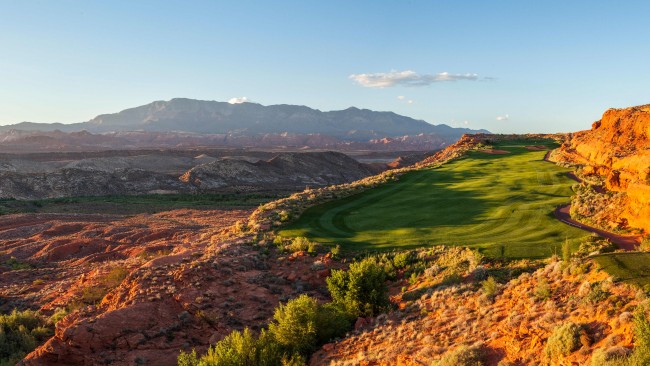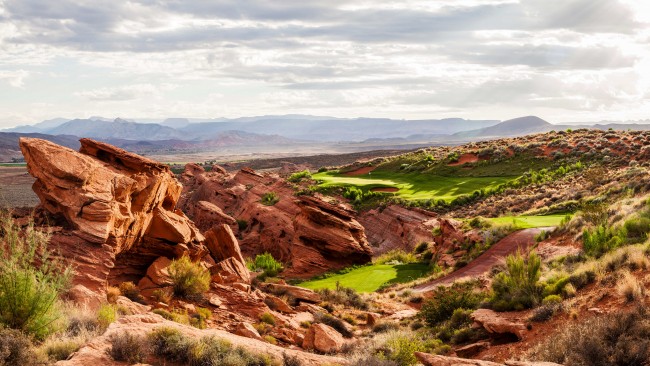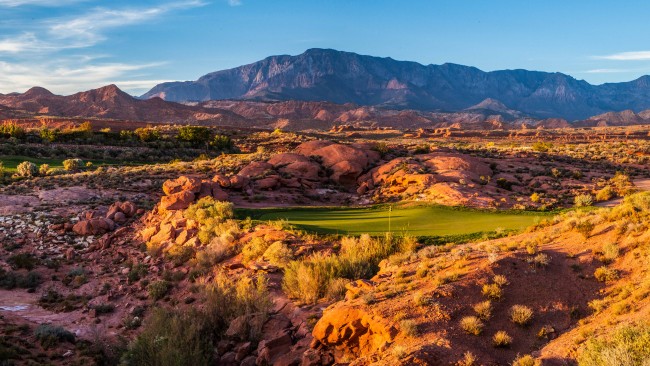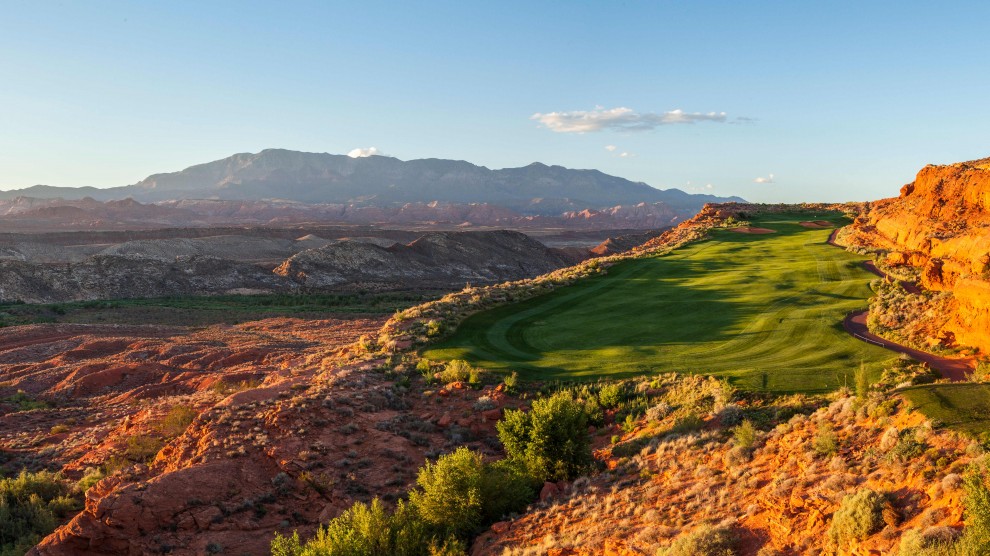It’s a complex and convoluted story, but almost certainly true – Sand Hollow G.C. in Hurricane, Utah probably wouldn’t exist were it not for the Desert Tortoise.

Gopherus agassizii and Gopherus morafkai may not have designed the course nor financed its construction, but without them it’s unlikely developer David Wilkey would ever have acquired the land on which to build this amazing layout 18 miles east of the city of St. George, which everyone who enjoys great golf in magnificent surroundings should play at least once in their life.
The tortoise, native to the Mojave and Sonoran deserts, had been plodding along happily for millions of years, avoiding dangerous exchanges with dinosaurs in its formative days, before Homo sapiens and their gluttonous plans for urban expansion shrunk its habitat drastically and introduced all sorts of contaminants. Poor old Morafkai wound up with Upper Respiratory Tract Disease and Cutaneous Dyskeratosis (which causes discolored lesions on the animal’s shell) that put it on the endangered list.
In 1996, the 62,000-acre Red Cliffs Desert Reserve was established in southern Utah to provide federal protection for the species. Administered by Washington County in conjunction with the United States Fish and Wildlife Service (FWS), Utah Department of Natural Resources (DNR), State of Utah School and Institutional Trust Lands Administration (SITLA) and the Bureau of Land Management (BLM), the reserve has enabled tortoise populations to stabilize, even thrive.
Wilkey, who had done much to promote the region to Japanese tourists before moving into commercial development, had purchased several hundred acres of condemned land, then traded it with the BLM to help it secure sufficient acreage for the tortoise sanctuary. In exchange, Wilkey received enough land to build the resort he was planning, but with it came a stipulation from the city of Hurricane that part be used for Recreation and Public Purpose (R&PP). In order to obtain the rights to develop, Wilkey was also required to undertake an archaeological dig to ensure no ancient artifacts would be affected.
“My group now sub-leases land from the city, which it leases from the BLM,” says Wilkey, whose part in helping the BLM establish the tortoise colony was critical, and who was obliged to pay something between $1 million and $2 million to complete the dig and clean up afterwards.
I told you it was a complex and convoluted story. And to be honest, that’s not even the half of it, because you obviously don’t build thousand-acre golf resorts on land this precious without a great deal of confrontation from parties eager to ensure no one ever lays a finger, foot or ATV on it.
Another key figure in the process that secured Wilkey the necessary license to build the golf course, appease the environmentalists, and ensure all the development team’s various responsibilities were met was Andy Staples, principal of the Golf Resource Group founded in Lehi in 2003.
Staples began talking with Wilkey in 2004 after being introduced by Mark Wetzel, the CEO of Utah’s largest golf course management company, Vanguard Golf.
“It was an awesome opportunity for a young company,” says Staples. “We hit it off immediately with David and were soon planning 27 holes, a learning center, community trails, ATV access and a water park.”
Wilkey is quick to identify Staples’ part in the whole process.
“Andy was sensitive and supportive, and played a very important role in helping us get the go-ahead,” says Wilkey.
Given the green light to proceed, Staples worked for a year or so deciding where golf could and couldn’t be played, routing the holes, and preserving sensitive sites that had been identified throughout the property.
As plans for the golf course took shape, however, Wilkey and his associates began to appreciate how special their land was.
“A number of people I trust suggested we needed a big name designer to give the course greater exposure,” says Wilkey who considered Phil Mickelson (“too expensive”), Davis Love III and Fred Couples before friend and nearby resident Bruce Hurst, a former pitcher for the Boston Red Sox, insisted he speak with John Fought.
“The first time I met John I knew he was our man,” says Wilkey. “He was just so excited about the project, and I liked his philosophy on golf and his ideas for the resort.”
Wilkey says Staples was happy for Fought to come on board but admits the two didn’t always see eye to eye.
“They certainly had their disagreements,” Wilkey says. “They especially had very different ideas on how the third green should look.”
Staples doesn’t comment on the relationship, though Fought will concede they weren’t always on the same page.
“Nothing personal, Andy did a lot of excellent and very important work,” says Fought. “But we did clash in a few areas. I wanted to bring a few of the tees closer to the greens, and make a few other minor adjustments.”
One issue they did agree on, however, was use of the dramatic natural cliffs that set the course several hundred feet above the Virgin River valley floor on the property’s western boundary. Neither was terribly keen to use the rim and draw attention away from other parts of the course, which terrain as spectacular as this would inevitably do.
“Both John and I tried to convince David not to use the rim,” says Staples, who also designed the resort’s extremely enjoyable, nine-hole Links Course. “There are so many interesting sand dunes and natural features throughout the property, we both felt using the cliffs wasn't necessary and that we could design him an incredible golf experience without the glitz and glam of rock holes.”
Fought, a stout traditionalist who prefers subtle, understated and unassuming design to ostentatious and often unnecessary eye-candy was likewise troubled by Wilkey’s desire to push the course as far west as it could go.
“That ground was obviously unlike the rest of the course,” he says. “So those holes would be so different. I didn’t think it was worth the expense.”
Knowing how the typical golfer’s mind works, however, Wilkey decided to build the rim holes. The glowing reviews they’ve received and the amount of discussion they generate indicate he was right all along.
“We were fortunate the benches on which the 12th and 13th fairways are located were entirely natural,” says Fought. “I mean they were just there. Had we needed to grade them or even blast any rock, I don’t think even Dave would have wanted to build them. Mother Nature was certainly on our side there.”
Sand Hollow hosts a 54-hole professional tournament that in just two years has become a prestigious event with a good purse and strong field made up of talented college players, club pros, mini-tour players and even the odd Web.com or PGA Tour member. Former Web.com and Canadian Tour player Tyler Aldridge triumphed in 2014, and this year’s event was won by PGA Tour player and Utah native Zac Blair who shot 18-under-par 198 for the three rounds.
“The tournament has quickly become a big deal in Utah,” says Wilkey. “The governor hosts the event, and this year we had an $80,000 payout.”
Sand Hollow opened in 2008, 43 years after St. George built its first course at Dixie Red Hills.
“The story goes Jim Colbert was in a coffee shop one day talking with some local businessmen about the possibility of bringing golf to the area,” says Reed McArthur, long-time head professional at Sunbrook GC, another of the City’s four municipally-owned courses. “Sid Atkin, president of the Chamber of Commerce and nephew of a former mayor, was among them. He and Jim were really the two that were able to get the idea off the ground.”
Civic leaders were notoriously conservative, however, and took a great deal of convincing golf was economically viable in the desert. A wealthy investor in St. George Bank named William Lassiter suggested using revenue bonds to raise the $60,000 needed to start work, and in August 1964, the city council relented, voting 4-1 to authorize use of bonds and city property.
Ernie Schneiter Sr. from Ogden, a hugely popular instructor and club pro who was elected to the Utah Golf Hall of Fame in 1991, was chosen to design the nine-hole course, and he did a fine job weaving some fun holes in between the surrounding red rocks.
Dixie Red Hills didn’t spawn a monster exactly, but four decades later, there are now 12 courses cutting green swathes through the red dust and rust-colored rocks that distinguish the region. Besides Dixie and Sand Hollow, eight of that dozen appear on the Red Rock Golf Trail and provide ample entertainment on a St. George golf trip. Except for Falcon Ridge, 40 miles south and west of St George in Mesquite, Nev., every course on the Trail is located within a few miles of your St. George lodgings so you can play them in any order you wish. Many, though, choose to go out with a bang at Sand Hollow, saving the best for last.
You might start at Coral Canyon, an excellent Keith Foster design that opened in the city of Washington, in 2001. Eight years later, original developer SunCor sold the surrounding property to the state’s school trust lands administration, and the course itself to Vanguard Golf Management which does a good job maintaining the 7,029-yard par-72 layout.
Before beginning work, Foster remembers visiting a couple of other courses in the area and coming away thinking them too narrow.
“I wanted Coral Canyon to be far more playable,” he says now. “This was going to be a public course, and I wanted visitors to be able to enjoy the magnificent scenery without worrying about losing their golf ball.”
Foster, who now divides his time between two course renovation jobs a year – currently the Harry S. Colt/Charles Alison-designed Century C.C. in Purchas, N.Y., and Donald Ross-designed Greensboro C.C. in North Carolina - and operating his fascinating antique store, The Outpost, in Middleburg, Va. -- speaks fondly of working in St. George, saying the people were charming and the scenery amazing.
“I loved my time there,” he says. “And I really enjoyed working on that site. The terrain was just fantastic; the natural rock outcroppings are so magical.”
There are a number of highlights. The par-5 first is a great way to start a round, but it is the cute par-3 sixth that you’ll talk about when recounting stories from your trip. Played over the edge of a canyon to a green set in the rocks, it’s one of those great par 3 tee shots you want so badly to strike well. A bad score at Coral Canyon doesn’t quite have its usual sting if you manage to hit a good tee ball at the sixth.
You’re quickly acquiring a taste for golf amongst red rocks now, and what better way to feed your new-found habit than with a round at The Ledges, 8 miles north of St. George on Highway 18, at the eastern edge of the amazing Snow Canyon State Park?
Matt Dye, nephew of Pete, designed this course of two halves which heads east for nine solid-but-relatively-tame holes before moving west for a rollicking back nine that includes a few you’ll have a hard time doing justice to when describing them at home. The stretch from the 11th to the 16th offers up incredible views of Snow Canyon and a series of captivating shots you’ll want to take on again and again.
Director of Golf Steve Sargent came to The Ledges after 11 years at Wolf Creek in Mesquite and has a plan to make the Ledges even better.
“I’m thinking about switching the nines,” he says. “I think it would be a good idea to have more of a wow-factor at the start of the round. The beautiful mountains would create an amazing first impression.”
That is certainly true, but should you start or finish with the fireworks? Before you answer that, let’s not run away with the idea the present front nine is in any way dull. It’s not. There are some very good holes, and the surroundings are finer than what you might find in roughly 47 other states.
You’ll say the same of Green Spring G.C. in Washington – Gene Bates’ first solo design effort that you can play for just $64 (with cart) between February and May, which is St. George’s high season. After finishing his apprenticeship and early career with Jack Nicklaus’ design company, Bates could not have been given a better property for his first unassisted job. It was handed to him by Salt Lake City doctor, Allan Barker, whom Bates had gotten to know while working on the short Cayman Course on Grand Cayman alongside Nicklaus. Dr. Barker and his brother Bob owned an RV park in Washington across the road from the property they had earmarked for golf, but the golf ground was a little small for a regular length course.
“So they intended building a Cayman course,” says Bates.
On its eastern edge, the site featured a 50-foot deep, 50-to-100-yard-wide canyon that begged for a golf hole to cross it, but Bates was stumped on what would happen next.
“The site was awesome with the canyon crossing the east end,” he says. “The soils were perfect and the views of Pine Mountain amazing. But there wasn’t enough land to build another hole on the side of the canyon where I wanted to put the green of the previous hole.”
Fortunately, Bob Barker, an excellent negotiator, was able to make a deal with the Utah State School Land Trust to purchase the necessary land on the east side of the canyon. Now Bates could build his all-world par 3, the fifth, and add an interesting par 4 with a 75-yard carry back over the canyon for the approach to the sixth green.
“The two holes work well, I think,” says Bates who has returned to Green Spring several times since it opened in 1989 to make minor adjustments and visit with old friends.
“Green Spring is really special to me because it helped propel my career to a place I never thought it could go,” says Bates. “It’s always in good condition, and I’m proud people really seem to enjoy playing it.”
There’s plenty more to enjoy in and around this city, named for Mormon apostle George A. Smith, and founded as a cotton mission in 1861 by fellow apostle Erastus Snow. As mentioned, the city itself owns four courses – Dixie Red Hills, Southgate, St. George, and the excellent, 27-hole Sunbrook with nines designed by Ted Robinson (Point and Woodbridge) and John Harbottle (BlackRock).
“I’d say the Point and Woodbridge is the most popular combination here,” says Reed McArthur. “People really love the Point. There are several memorable, dramatic holes. The views with the elevation changes are superb, plus it’s a little less demanding than both Woodbridge and BlackRock.”
Colby Cowan, Director of Operations for St. George City Golf, and a former head pro or Director of Golf at Coral Canyon, The Ledges and Sand Hollow, explains the appeal of playing golf in his hometown.
“Obviously people love the scenery,” he says. “But they also love the courses’ playability and the fact rounds here are surprisingly affordable given how good each layout is.”

The city of Hurricane also offers some of that excellent value for your golf dollar with a round at the stunning Sky Mountain course, costing just $65 with cart in peak season. Jeff Hardin designed this 6,383-yard beauty that you should perhaps play on your way to Zion National Park, the entrance to which is just 26 miles to the east on Highway 9.
The acclaimed, Johnny Miller-designed Entrada at Snow Canyon may not be part of the Red Rock Golf Trail but shouldn’t be missed. You may have to stay on-site to get a tee time, but St. George’s finest golf tour operator, St. George Utah Golf, can handle all your golf and lodging requirements.
That said, your ‘requirements’ for a golf trip to St. George, Utah, will be simple enough – a clean and comfortable hotel with a bed, shower and breakfast – and nothing fancy, and as much of this incredible golf as you can possibly fit in.
Where to Stay

The Red Rock Golf Trails makes no claims about being a luxury destination. If you want five-star accommodations in hotels with the shiniest bells and loudest whistles you’ll need to go elsewhere. But don’t let that prevent you from experiencing such memorable golf. The Holiday Inn Express, a two-minute drive from Coral Canyon, Best Western Coral Hills in the historic downtown, Hilton Garden Inn, Wingate by Wyndham, Clarion, La Quinta, Towne Place Suites and Courtyard by Marriott are all you could possibly need.
Where to Eat
You’ll obviously find all the chain restaurants you need, but with the cash you save playing such affordable golf and staying in affordable hotels, you should make room in the itinerary for a couple of excellent meals – at the Painted Pony in Ancestor Square where you can enjoy some bacon-wrapped duck, or an exquisite Hanger Steak cooked in a red wine sauce, and the Cliffside Restaurant on Airport Rd, overlooking the city. Opened in April 2014 by Tom and Dorothy Heers, the Cliffside’s signature dishes include chili-glazed salmon, chicken-fried chicken and Lilikoi (passion fruit) Cheesecake.

